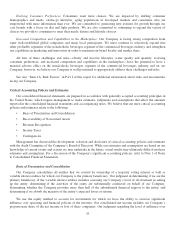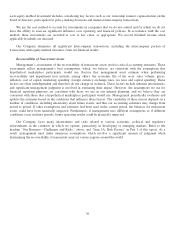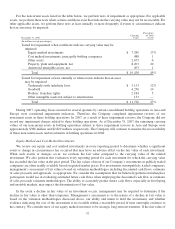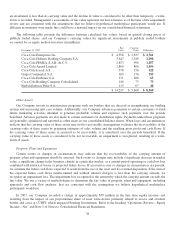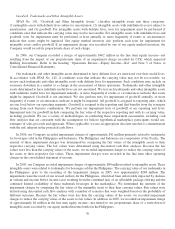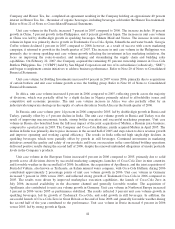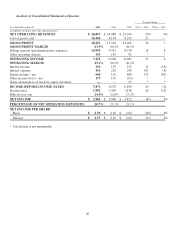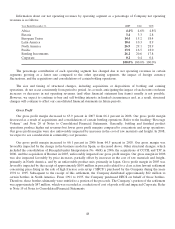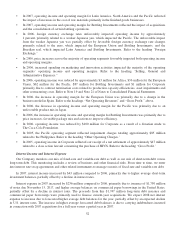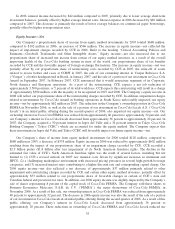Coca Cola 2007 Annual Report Download - page 45
Download and view the complete annual report
Please find page 45 of the 2007 Coca Cola annual report below. You can navigate through the pages in the report by either clicking on the pages listed below, or by using the keyword search tool below to find specific information within the annual report.Unit Case Volume
Although most of our Company’s revenues are not based directly on unit case volume, we believe unit case
volume is one of the measures of the underlying strength of the Coca-Cola system because it measures our product
trends at the consumer level. The Coca-Cola system sold approximately 22.7 billion unit cases of our products in 2007,
approximately 21.4 billion unit cases in 2006, and approximately 20.6 billion unit cases in 2005.
In Africa, unit case volume increased 10 percent in 2007 compared to 2006. The increase in 2007 reflected growth
across all divisions, led by growth in South Africa. South Africa unit case volume increased 13 percent in 2007, driven
by strong marketing, the replenishment of trade inventory resulting from the carbon dioxide shortage in the fourth
quarter of 2006, and favorable weather. Solid growth in North and West Africa, and in East and Central Africa, driven
primarily by strong marketing and bottler execution, also favorably impacted the results in 2007.
In Eurasia, unit case volume grew 16 percent in 2007 versus 2006. Double-digit unit case volume growth in
Russia, India, Turkey, Middle East, Eastern Europe and southern Eurasia drove the results. In India, continued
investment in marketing initiatives on the quality and safety of our products and focus on improved execution by the
consolidated bottling operations resulted in 14 percent unit case volume growth in 2007.
Unit case volume in the European Union increased 3 percent in 2007 compared to 2006, primarily due to growth
in most key countries. The results reflected the benefits of key initiatives across the group, including Coca-Cola Zero
launches and the three-cola strategy (focusing on driving unit case volume growth for Coca-Cola, Coca-Cola Zero and
Diet Coke or Coca-Cola light.), The Coke Side of Life Campaign, Christmas programs and activation of the Rugby
World Cup. In addition, the full-year impact of the 2006 acquisition of Apollinaris GmbH, a German premium source
water brand (“Apollinaris”), and the 2006 joint acquisition of Fonti del Vulture S.r.l. (“Fonti del Vulture”), an Italian
mineral water company, with Coca-Cola Hellenic contributed to unit case volume growth in 2007. Unit case volume
growth in the European Union was negatively impacted by the unseasonably cool and rainy summer weather compared
to 2006 and the impact of World Cup in 2006.
In Latin America, unit case volume increased 9 percent in 2007 versus 2006, including 7 percent growth in
Trademark Coca-Cola, reflecting the introduction of Coca-Cola Zero during the first quarter of 2007. The acquisition of
Leao Junior in Brazil also favorably impacted the unit case volume growth in 2007. Unit case volume increased
16 percent in Brazil, 6 percent in Mexico and 9 percent in Argentina in 2007 versus 2006. In December 2006, the
Company and Coca-Cola FEMSA entered into an agreement to jointly acquire Jugos del Valle, the second largest
producer of packaged juices, nectars and fruit-flavored beverages in Mexico and the largest producer of such products
in Brazil. In July 2007, the Mexican Federal Competition Commission approved the acquisition of Jugos del Valle. The
transfer of ownership was completed in November 2007. Full-year 2006 unit case volume of Jugos del Valle was
approximately 117 million.
Unit case volume in North America decreased 1 percent in 2007 versus 2006, reflecting a 1 percent decline in the
Foodservice and Hospitality Division due to the challenging restaurant industry environment. Unit case volume in the
Retail Division was even in 2007, reflecting a 1 percent favorable impact from acquisitions primarily related to
glacéau. In 2007, the Company transferred the majority of the distribution of glacéau branded products to its existing
bottling system with the exception of certain regional glacéau distributors and certain channels. Refer to Note 20 of
Notes to Consolidated Financial Statements. Unit case volume for glacéau beverages was 56 million unit cases in 2006.
The Retail Division’s unit case volume result was unfavorably impacted by the difficult sparkling beverage industry
environment and by a unit case volume decline in warehouse-delivered water resulting from the strategic decision to
refocus resources behind the more profitable Dasani business. Sparkling beverage unit case volume declined 2 percent
in 2007 compared to 2006, reflecting the expected difficult category environment resulting from increased retail
pricing. Coca-Cola Zero unit case volume continued to increase by double digits in 2007. In 2007, both Trademark
Dasani and Trademark Powerade unit case volume continued to grow. Warehouse-delivered juice unit case volume
declined due to retail price increases taken to cover higher ingredient costs. This decline was partially offset by
continued unit case volume growth in Trademark Odwalla and Trademark Simply juices. In February 2008, the
43




